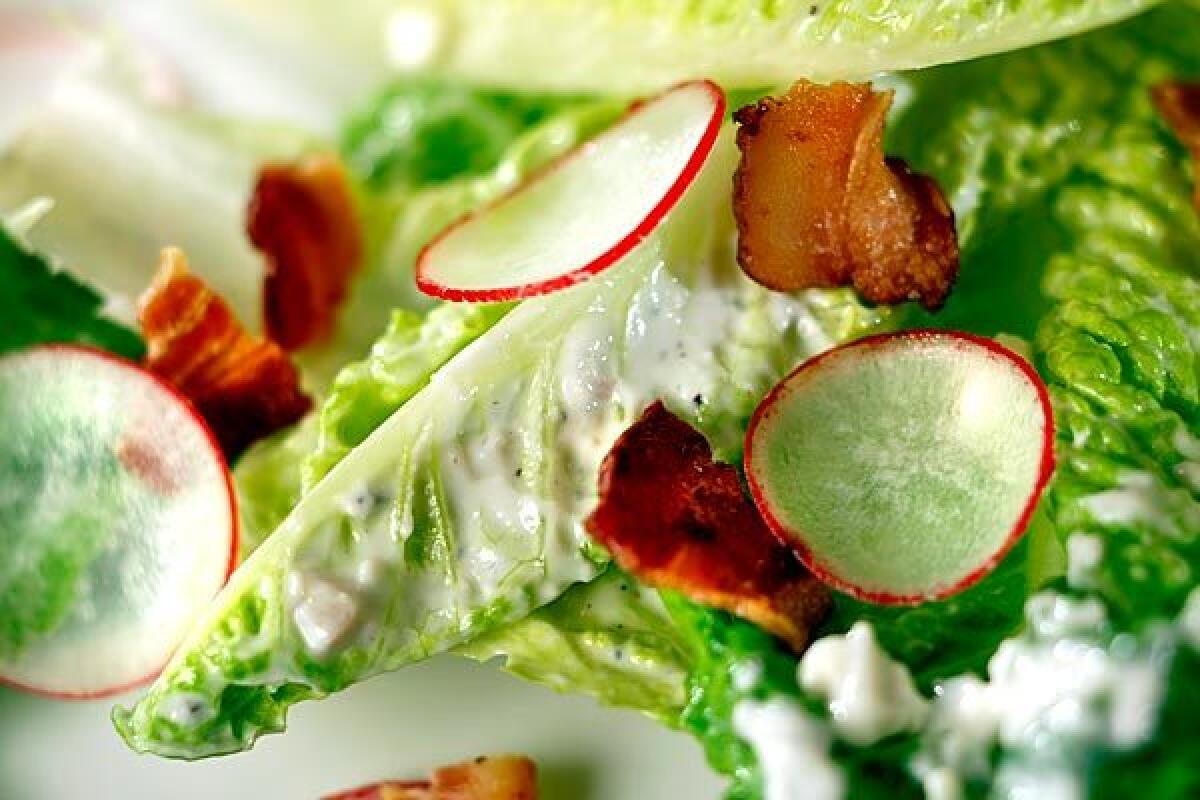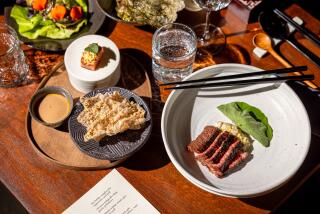Rise of the modern romaine empire

A lot of times when food writers praise an old-fashioned ingredient such as romaine lettuce, they do it with a nod and a wink and more than a hint of condescension, like fashion critics chortling when a Parisian couture house sends its models out dressed in gingham and lace -- âOh, how very droll!â
Not me. If food is good, itâs good and fashion be damned. And romaine is good.
Donât get me wrong, I like my fancy mesclun style lettuces as much as anyone -- Iâve got a full bed of them in my garden and I trot out to cut my salad greens in the evening just as happily as any other Alice Waters acolyte. Those fancier lettuces have a vivid mix of flavors that I love. (Iâve got one Asian mustard that is hot as horseradish.)
But romaine has something they lack -- crunch. And sometimes crunch counts. Those mixed lettuces are terrific with good olive oil, a squirt of lemon juice and a sprinkling of sea salt. But if youâre looking at a salad with more heft, a real American salad, you need a lettuce with some structural integrity.
Want a wedge of something to go under a creamy blue cheese dressing (lots of black pepper please!)? How about a classic Green Goddess, redolent of anchovies, chives and tarragon? And, of course, you shouldnât even think of a Caesar without picking up a head of romaine.
Indeed, it was this last salad that sparked the rebirth of romaine lettuce and one of the more remarkable turnarounds in modern agricultural history.
Romaine lettuce has been around for centuries. In fact, Egyptian tomb art depicts a lettuce that looks quite like it. In England, itâs sometimes known as cos lettuce, allegedly because it was brought from the Aegean island of that name. The name romaine comes because it was supposedly introduced to France when the pope moved from Rome to Avignon in the 14th century.
Hail, Caesar
But for much of the 20th century, romaine wasnât known at all to many Americans. Thatâs because of the overwhelming success of iceberg lettuce, which can remain reliably crunchy (though incredibly bland) despite days if not weeks of shipping. As late as the mid-1970s, iceberg lettuce accounted for more than 95% of all of the lettuce grown in this country.
Then along came the reborn Caesar salad. Invented in a Tijuana restaurant in the 1920s (which one is a subject of a bitter interfamilial dispute), for decades the Caesar kind of limped along in all of its garlicky glory as a California specialty.
Then, all of a sudden, in the late 1970s it was âdiscoveredâ by the fast food industry, often topped with very untraditional grilled chicken, and there followed a couple of decades of extremely heady popularity.
From almost nothing, by the mid â90s, more than 16,000 acres of romaine was being grown. By 2000 that had increased to more than 60,000 acres and today it stands at more than 80,000.
Thatâs still about half of icebergâs acreage, but especially considering the high percentage of iceberg that winds up on top of hamburgers, itâs pretty impressive.
And I have to say I do my best to use my share.
I like romaine in midweek dinners, which in my house often consist of dishes such as scraps of Sunday roast chicken, bound with a bit of mayonnaise and brightened with herbs, reconfigured as a salad.
And speaking of which, next time you roast a chicken (or most anything else for that matter) try this: Drain off a couple tablespoons of the fat, then deglaze the pan with a bit of red wine vinegar and stir that into the fat; toss with romaine.
(A couple of side notes: While the whole head is good enough for family dinners, if you want a little more elegance, trim the floppy outer leaves -- save them for another meal, the compost, or a bunny, if you have one -- and serve just the pale crisp hearts. Furthermore, when theyâre trimmed this way, the lettuce spears are easy to eat with your fingers.)
Dressed to thrill
Almost anything that takes an American-style salad dressing should be built from romaine. (Years ago we had an Italian exchange student stay with us; the first time she was asked at a restaurant what kind of salad dressing she wanted, she was flabbergasted. âOil, vinegar? How many kinds can there be?â)
Well, thereâs blue cheese, of course. Mash crumbled cheese into mayonnaise along with some minced shallots, then stir in just enough cream to make it pourable. I think the real key to a great blue cheese dressing is lots of black pepper, but thatâs just me.
My favorite way to use blue cheese dressing is my spin on a steakhouse staple: with crumbled bacon and thinly sliced radishes over romaine.
Or what about homemade Green Goddess? If youâve only had store bought, youâre in for a surprise. A well-made Green Goddess is one of the great flavored mayonnaises -- tangy with anchovy and brightened by lots of fresh herbs: parsley, chives and, especially, tarragon.
Because of this, I find it is a great sauce to pair with seafood and chicken. Shrimp, for example, with some torn watercress leaves mixed in just for a bit of a peppery bite. On top of romaine, of course.
And romaine is also good treated like radicchio: grilled and served with a slightly chunky dressing of anchovies and garlic purĂŠed with olive oil. Scatter over the top toasted walnuts and graceful ribbons of shaved Parmigiano-Reggiano, and, finally, youâve got a romaine salad even my little Italian friend would recognize.
More to Read
Eat your way across L.A.
Get our weekly Tasting Notes newsletter for reviews, news and more.
You may occasionally receive promotional content from the Los Angeles Times.










